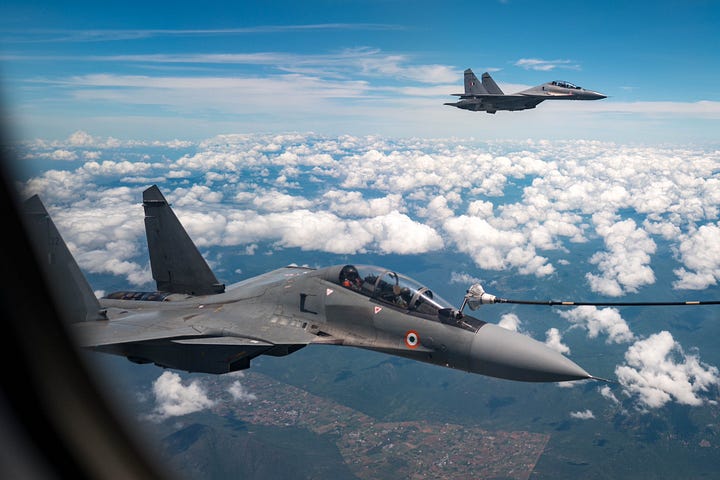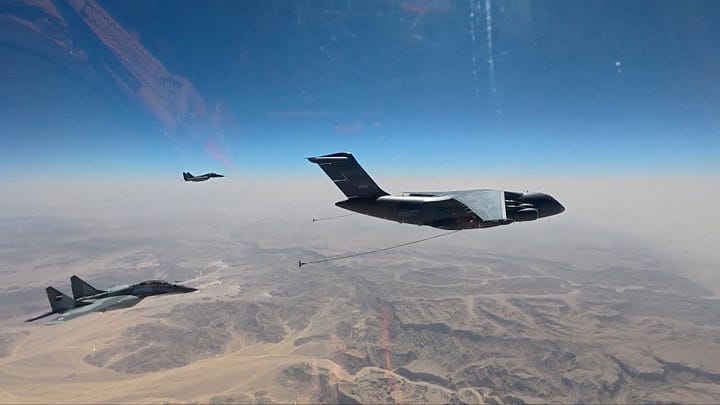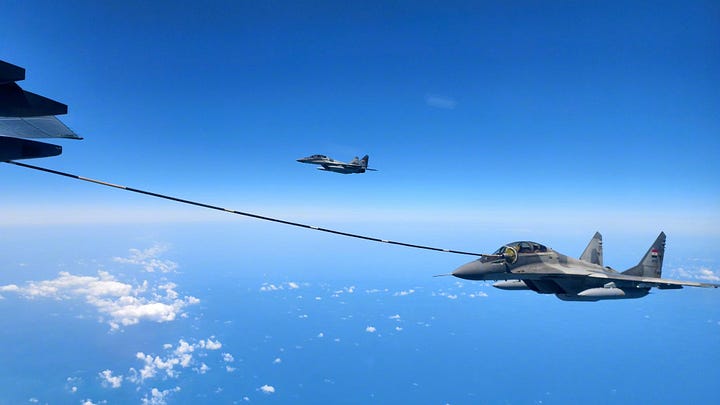

The above images capture Indian Su-30MKI fighter aircraft, which are of Soviet-Russian origin in the same manner as the Chinese People’s Liberation Army Air Force’s (PLAAF) J-16 fighters, being refuelled from Airbus A330 MRTT aerial refuelling/tanker aircraft. There is, at this time, no public indication that any PLAAF fighter aircraft, including the J-16, have ever been refuelled by a foreign tanker aircraft, although the practice of PLAAF aircraft being refuelled by Russian Air Force and Pakistan Air Force aerial refuelling aircraft cannot be ruled out.
There are two primary methods to aerial refuelling: the use of a flying boom, in which the aerial refuelling aircraft is equipped with the rigid telescoping pipe that transfers fuel while the receptacle-equipped receiving aircraft maintains a steady course, and the probe and drogue method, which requires the receiving aircraft to maneuver so that the probe equipped on the receiving aircraft connects with the drogue that is extended by and trailing behind the aerial refuelling aircraft via a flexible hose through which fuel is transferred. The former method, the flying boom, is almost exclusively used with American-designed military aircraft, particularly those operated by the United States Air Force. The latter method, the probe and drogue, is widely employed worldwide but, in the American context, is almost exclusively associated with aircraft operated by the United States Navy, United States Marine Corps, and United States Army. There are pros and cons to each method, with the flying boom offering a higher flow rate, which is an important consideration when it comes to refuelling bomber aircraft, military transport aircraft, and similarly large and heavy aircraft that need to receive a much greater amount of fuel than the likes of a fighter aircraft.
The PLAAF exclusively makes use of the probe and drogue method to refuel its J-8, J-10, Su-30, J-16, J-20, and J-35A fighter aircraft, as well as its H-6N bombers and some its its KJ-200 and KJ-500 airborne early warning and control (AEW&C) aircraft. While some foreign aerial refuelling designs, such as some configurations of the A330 MRTT, can refuel aircraft through both methods, this is not the case with the PLAAF’s Il-78, YY-20A, and Y-20B/YY-20B aerial refuelling aircraft, which are exclusively configured to refuel aircraft through the probe and drogue method given that these are not equipped with a flying boom. As a result, PLAAF aerial refuelling aircraft cannot, for example, refuel Pakistan’s American-built F-16 fighter aircraft, which are equipped with a receptacle for a flying boom, but should be capable of refuelling Pakistan’s French-built Mirage aircraft, which are equipped with a refuelling probe (through which these are regularly refuelled by Pakistan’s Soviet-Russian Il-78 aerial refuelling aircraft, which can also refuel probe-equipped PLAAF fighter aircraft just as Pakistan’s Il-78s refuel the country’s Chinese-designed JF-17 and J-10CE fighter aircraft).


As of this writing, there is only one publicly known instance in which a PLAAF aerial refuelling aircraft has refuelled a foreign military aircraft. In April-May 2025, China and Egypt held a bilateral military exercise, which was hosted by Egypt, for which the PLAAF deployed not only J-10 fighter aircraft but, among other things, a YY-20A aerial refuelling aircraft that was recorded refuelling Egypt’s Russian-built MiG-29M fighters. While the Egyptian Air Force operates probe-equipped French-built Rafale and Mirage 2000 fighter aircraft that should have been able to receive fuel from the Chinese YY-20A, Egypt’s French-built fighter aircraft are not understood to have participated in the bilateral China-Egypt military exercise in the same manner of the country’s large fleet of American-designed F-16 fighters, which can only be refuelled through the use of a flying boom.
While the PLAAF’s aerial refuelling aircraft should be able to refuel most of the probe-equipped aircraft operated by foreign air forces, aerial refuelling is not haphazardly undertaken and some testing—without the actual transfer of fuel—is typically conducted to verify the safety of the approach and establish the correct procedure for aircraft type A to receive fuel from aircraft type C, as opposed to aircraft type B. This is not something that the PLAAF can do itself without the cooperation of foreign militaries and their non-Chinese origin aircraft. Until such compatibility is demonstrated, such as in training events with foreign air forces, Chinese aerial refuelling aircraft, namely the YY-20A and Y-20B/YY-20B, are unlikely to be seriously considered by foreign militaries. Similarly, Chinese fighter aircraft such as the J-10C, J-20, and J-35A will likely be less competitive on the export market unless they have a demonstrated ability to receive fuel from foreign aerial refuelling aircraft, such as the Airbus A330 MRTT. Should China demonstrate the ability of Chinese-designed aircraft to receive fuel from foreign-designed aerial refuelling aircraft and the ability of Chinese-designed aerial refuelling aircraft to provide fuel to foreign-designed aircraft, potential export customers such as Indonesia will likely be more willing to consider procuring Chinese military aircraft.
While the ability of PLAAF aerial refuelling aircraft to refuel foreign military aircraft is important in the context of Chinese armament exports and bilateral and multilateral training events, the non-demonstrated ability of PLAAF aircraft to receive fuel from foreign aerial refuelling aircraft is also a liability for the PLAAF. If PLAAF aircraft could receive fuel from, for example, an Emirati or Saudi Airbus A330 MRTT aerial refuelling aircraft, the PLAAF could more readily deploy aircraft for bilateral or multilateral training events with foreign countries in the Middle East or, for example, deploy to Djibouti, which is home to a Chinese military base. Similarly, if the PLAAF is to ever undertake joint combat operations with a foreign military other than Pakistan, it will need to verify the ability of Chinese-designed fighter aircraft to receive fuel from foreign military aircraft. As with so many areas of Chinese military capabilities, aerial refuelling remains a work in progress, even though it is a mundane undertaking for most major militaries, including a country like India that operates a very diverse fleet of military aircraft with a demonstrated capacity to receive fuel from foreign aerial refuelling aircraft.

